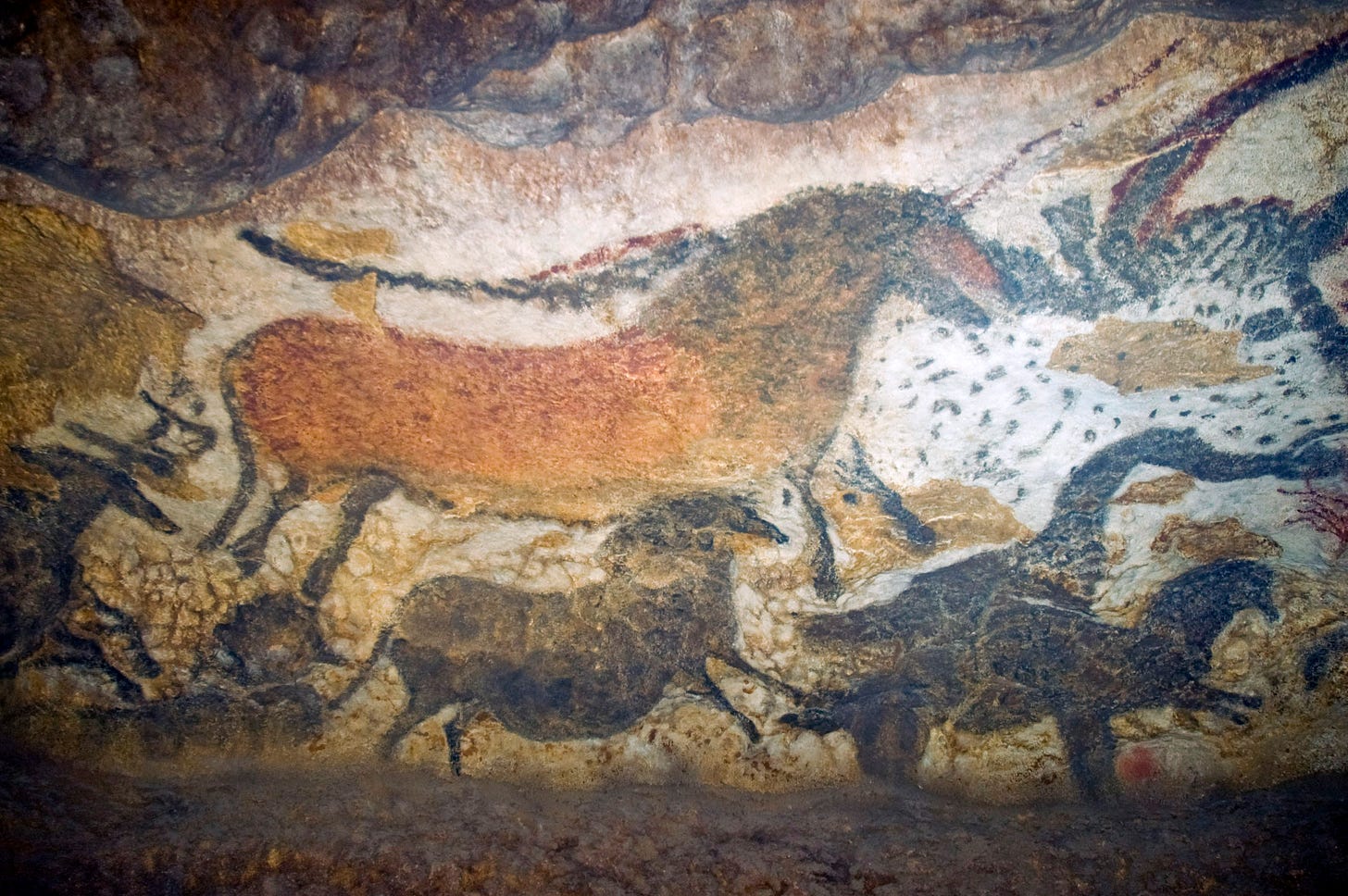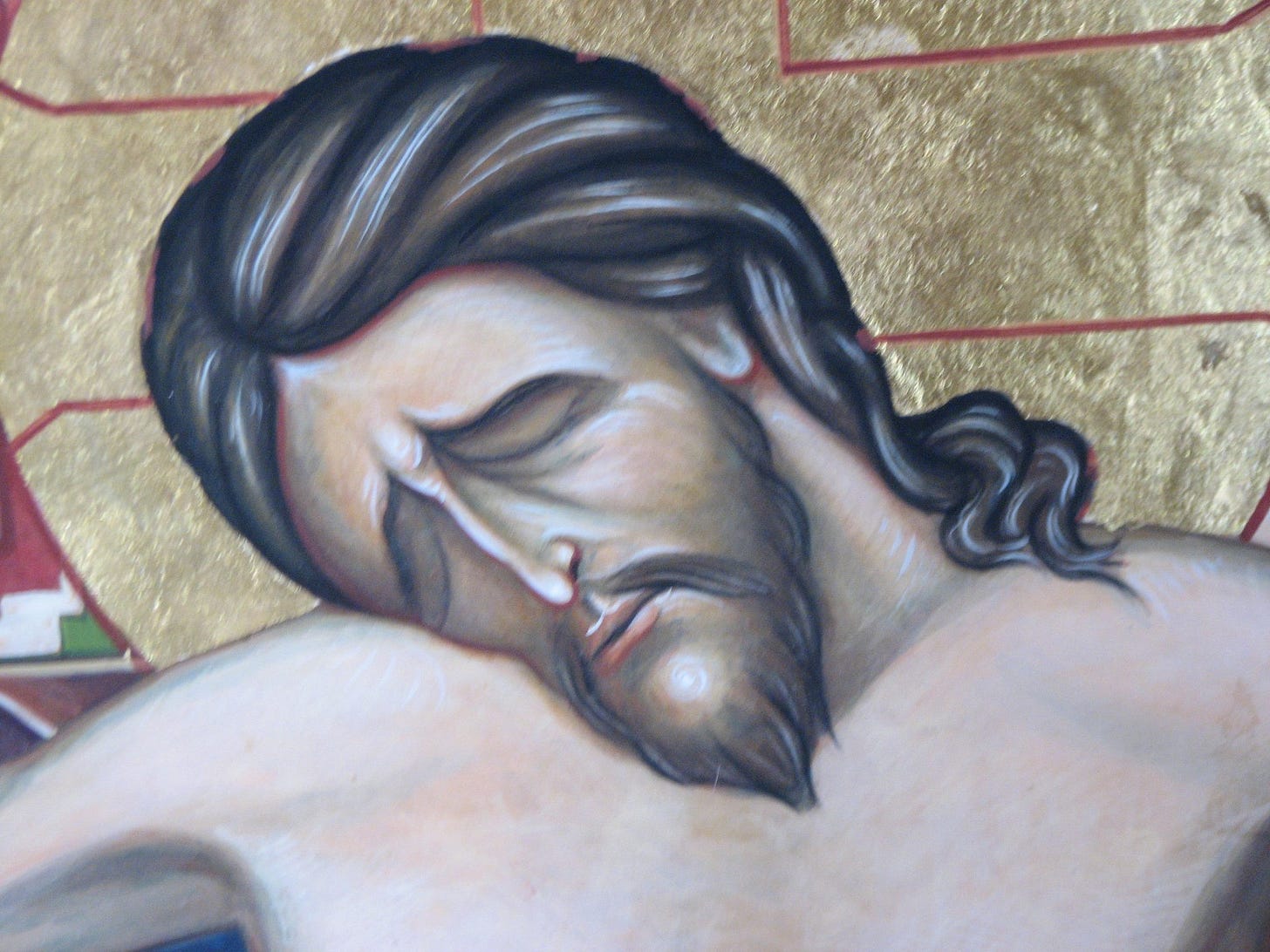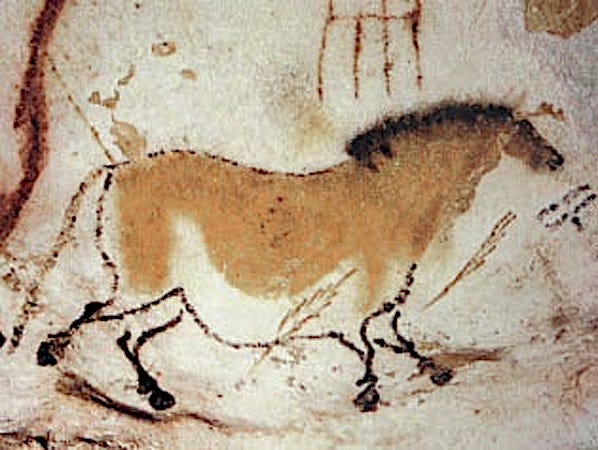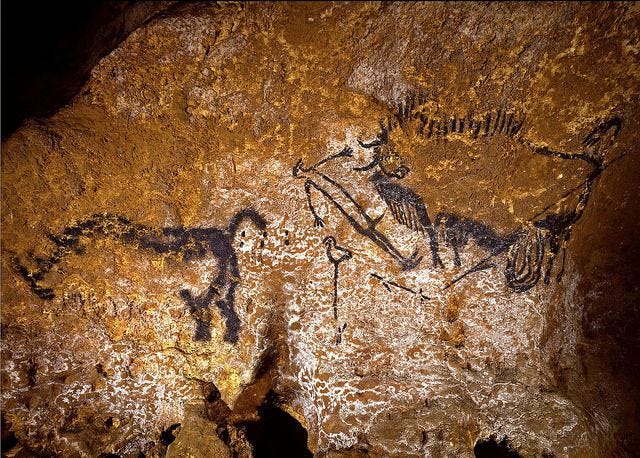...And Lessons that Could Be Learned From Them by the Neandertals in Our Universities
Here are wall paintings from underground caverns in Lascaux in the Dordogne region of southwest France, east of Bordeaux. Around 600 paintings exist in a network of underground caverns; archeologists estimate that they were painted during the Upper Paleolithic period, about 15,000 years ago. They were discovered in 1940 by an 18-year-old boy taking his dog for a walk, when the dog wandered into a hole in the ground leading to the cavern system. The paintings depict animals, plants, and one humanoid form—a man with a bird’s head. Although the exact reason for their creation is unknown, it is speculated that they hold some spiritual significance and are connected to ritualized worship.
The Natural Desire for God
The generally accepted view amongst theologians today is, as I understand it, that man’s desire for God is natural but not innate. (1) There is an important distinction here. It is considered natural because it arises from the power of natural reason. However, it is not innate, meaning that the inclination to worship God is not an instinct we are born with. This inclination arises instead from our observation and reflection upon the nature of the world around us.
When they observe the world and see its vastness, beauty, order, and grandeur, many different people have, over millennia, concluded that a divine being (or beings) created and orchestrates it, and that any being capable of doing such a wonderful thing is greater than us and worthy of worship.

Some, even without Revelation, would get close to the truth. Ancient Greeks, like Socrates, Plato, Aristotle, and their successors, even deduced the existence of a single god or supreme Good—what one might call the “god of the philosophers”. But these are exceptions. While, as St. Thomas tells us, it is theoretically possible to use natural reason alone to deduce the existence of a single, all-powerful, all-good, and all-loving God, most societies throughout history did not reach this conclusion. Typically, they fashioned false deities, and their forms of worship were flawed. Yet, at its core, for all that, such paganism is an expression, albeit imperfect, of man’s natural desire for God. As we have stated, human reason is weak, and it is not a given that people can reflect upon the natural world and get as far, even, as concluding that there is a God or gods. Some fall at the first hurdle and reach the opposite conclusion. Accordingly, atheistic systems of thought have also arisen, often, although not always, as parallel streams of thought in predominantly religious societies and as a reaction to the religious mainstream. Even where there is no supernatural being posited in the core teachings of a system of thought, such as in Buddhism, supernatural and metaphysical elements do creep into their practices and beliefs informed by local cultures. In traditional Buddhist societies, there is mention of devas and spirits in their literature, and there are temples, which are places of quasi-religious activity such as chanting, meditation and the study of Buddhist texts. And this also inspires the creation of art - we see statues of the Buddha in Buddhist temples.
 |
| The interior of a Buddhist temple in Bangkok (Image from Wikimedia Commons by Chainwit, CC BY-SA 4.0) |
As we have said, neither the desire for God nor the virtue of religion are instinctive. Therefore, it is not instinctive for us to worship anything. Both arise from the use of natural reason. However, even pre-historic man was capable, it appears, of sophisticated rational thought, as evidenced by this art linked to his worship. It is one of the oddities of the modern age that so many people do not worship any god or gods and are, in this respect, one might argue, more primitive in their worldview than Upper Paleolithic man. We might describe the contemporary atheist materialist, somewhat mischievously perhaps, as philosophically sub-Paleolithic!
As followers of Christ, we are privileged to have the gift of Revelation. God has revealed Himself to us in the person of Christ, who established the Church and the patterns of authentic worship in the liturgy. To be a practising Christian is not a sign of philosophical sophistication - though philosophically sophisticated some may be - but of an openness to the gift of faith.
 |
| The face of the suffering Christ in the Franciscan Gothic style, painted by me. |
The same may be said about the use of art in worship. Through his Church, Christ has informed us that the veneration of sacred art, which portrays the person of Christ, the Mother of God, and the Saints, is not merely allowed, but is an essential part of our worship and the practice of our faith. (3) This understanding helps us discern that even the simplest artistic depictions of divinity, as shown here, are a natural and wise anticipation of what God would later reveal to us personally and through His Church.
Education and formation can cultivate this natural desire for God and help direct it to its proper end: Christian worship. This supernatural end is the prime goal of all sound education. Pope Benedict spoke of this and the need for good catechesis for initiates in the Faith, young and old. He also spoke of the need for a continuing formation in right worship after the rites of initiation, which he termed mystagogical catechesis directed to a deepening of the mysteries of the Faith. This would include teaching people to understand and value sacred art and venerate holy images appropriately.
Conversely, external influences can erase or misdirect that natural desire for God. One of the sad facts of contemporary society is that much of contemporary education is anti-Christian propaganda and is at the heart of the ‘sub-Paleolithic’ contemporary mainstream in this regard, and is an ideology that dominates our elite universities. We see the propagation of atheist Marxist ideologies through the schools and universities and the cultural institutions of Western culture such as Hollywood. Marxists typically seek to eradicate any inclination toward ritual or veneration of the divine as part of their mission to destroy the West as we know it. The very act of worship implies, at the very least, the existence of the metaphysical—a notion antithetical to their atheistic, materialist philosophies. However, these ideologies do require complete subservience to, if not actual worship of, the false god of the state, so undermining human freedom and stifling our chance of happiness by exercising that freedom in the pursuit of God.
Even the Marxists realised the importance of art in this mission. To this end, Marxists have always engaged with the popular and intellectual culture; as part of their propaganda, they create images that further their goals.
 |
| Image from Wikimedia Commons by Mark Scott Johnson, CC BY 2.0 |
2. Summa Theologica, II-II, Q. l xxxi.



